
The Mets really are their own worst enemies, and it all starts with what is a terrible Public Relations Department.
The Mets’ ace, Matt Harvey, was dealing with a private medical issue. He had blood clots in his bladder. The causes for blood in the urine can be scary. It can be caused by kidney stones, cancer, or in Harvey’s case, holding it in too long. The number one thing to take from this whole situation is that Harvey is healthy, and he will be ready to pitch on Opening Day.
However, that doesn’t mean there isn’t a problem here. Why did Matt Harvey have to go through this publicly at all?
Harvey had tests and a procedure done by this morning. The Mets could’ve said Harvey was going to miss today’s Spring Training start because he had the flu, or they wanted to give someone else a start while Harvey threw on the side, or literally anything else where you don’t announce to the world that Harvey is dealing with a private medical issue. While he is dealing with this, many people are cracking jokes or making nasty comments. Well, Harvey noticed:
Matt Harvey also chided people for the "nasty things" they speculated his condition might be. He's fine now. #Mets
— Anthony DiComo (@AnthonyDiComo) March 29, 2016
Again, why was Harvey subjected to this? In part, it’s because people like to make jokes. The bigger issue is the Mets made an announcement before one needed to be made. They made a private matter a public matter and subjected their ace to ridicule. By the way, now that the news is out that Harvey is alright, new jokes have emerged. This is a failure of epic proportions by the Mets organization.
It’s not the first time Mets players have had a real issue with how the front office, and specifically Jay Horowitz, prioritizes the media over its own players. As Mike Piazza wrote in his autobiography, Long Shot (p. 259):
Because I’d the huge shadow the Yankees cast in the city, it seemed to me and other players that the Mets chronically catered to the press in the continual effort to get attention. In the process, they often exposed us – almost sacrificed us, in effect – to the jaws of the New York media monster. Our publicity director, Jay Horowitz, was a good guy who worked hard and loved the ball club, but I felt that he was more loyal to the writers and broadcasters than he was to the players.
******************
[The front office’s] position seemed to be that players come and go but the stations and newspapers will always be around. The effect, for us, was a sense that we were constantly walking the plank with the sharks circling below.
Once again, the Mets were more concerned about playing nice with the media rather than protecting one of its players. It was a problem with Piazza. It still seems to be a problem today.
So overall, the Mets have no problem sacrificing their players and their privacy to the media. They have no issues subjecting their players to ridicule for what are serious health issues. Harvey deserved better than this. Piazza and his teammates deserved better when they were playing.
The funny thing is that while the Mets have no problem having their players have to answer questions about private matters like their health, they are still ducking the media when it comes to the Madoff scandal or Jeff Wilpon firing a single mother. You see the Mets cozying up with the media only works when it comes to their players. When it comes to their own issues, they are nowhere to be found.
There will be jokes that follow Harvey the rest of his career because of this. It never needed to happen. The Mets failed one of their players by subjecting him to mockery and ridicule they don’t allow themselves to face. The Mets front office is the real joke here.
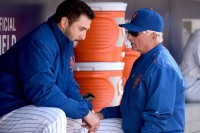
The worst thing that can happen to the Mets is them losing one of their pitchers for any period of time. With Matt Harvey‘s undisclosed and unknown medical situation, this fear is now a reality.
The scary part about it is how it has escalated. First, the Mets assumed he was hung over. Then, they thought it wouldn’t prevent him from making his next Spring Training start. Now, he’s flying back to New York for further examination. He’s most likely going to miss Opening Day. The players don’t know what’s going on, and they are praying for him.
The only thing we do know is Harvey’s arm is fine, or as only Terry Collins can put it, “His arm is fine! His arm is fine! Ok? His arm is fine.” This is leading to speculation as to what is wrong with Harvey, and there is no shortage of opinions.
This is because no one knows what’s happening. Part of that is HIPAA laws. Part of that is the Mets making an announcement before having all of the information. A large part of it is Harvey’s Bravo appearance and general assumptions fans have about him.
Hopefully, this is a relatively minor issue not only because of the Mets season, but more importantly, this is a man’s health we are talking about here. With that said, I’m reminded of other instances where a player’s health has postponed, derailed, or ended a player’s career.
As Mets fans, we have seen our fair share of problems. There was Ike Davis‘ bout with Valley Fever. Jose Reyes was found to have a thyroid condition. Just last year, there was David Wright and his spinal stenosis diagnosis. Elsewhere, there have been far more life threatening medical issues.
Jon Lester battled lymphoma before coming back and winning the clincher of the 2004 World Series. Brian Picolo would go from an NFL player to dying from cancer. There was also the day fifteen years ago when Magic Johnson retired from the NBA when he discovered he contracted HIV.
We don’t know what Harvey’s medical issue is. We may never know. The only thing we do know is no one wants to see something happen that will not only forever alter Harvey’s career, but also his life. So while we know his arm is alright, we don’t know if he’s alright. We don’t know what, if any effect, this will all have on his career.
Like Travis d’Arnaud and the rest of the Mets, all we can do is pray that Harvey will be alright.
Editor’s Note: this article first appeared on metsmerizedonline.com
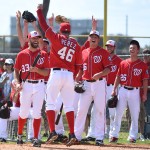
Mostly, you should ignore Spring Training. The only results that matter is how a player is progressing toward getting ready for the season. That’s much more important than their stats or a team’s Win-Loss record. However, I do admit there is one aspect of Spring Training that has me troubled.
Things have been very quiet in Washington.
Last year, Bryce Harper went from asking where his World Series ring was to getting choked by Jonathan Papelbon in the dugout. Ian Desmond rejected a contract extension worth over $100 million, and he was entering a contract year. The pressure of which was too much, and he faltered last year. The Nationals opened the year with big players like Anthony Rendon, Denard Span, and Jayson Werth on the Disabled List. Each would play less than 90 games. Stephen Strasburg struggled out of the gate, and he would miss some time with a shoulder injury.
This all proved to be too much for the 2015 World Series favorites. It’s a lot for a good manager to handle. It’s a disaster when your manager is terrible. That’s what the Nationals’ 2015 season was – a disaster.
Well, the Nationals cleaned house. They brought in three time NL Manager of the Year Dusty Baker. They added character guys like Daniel Murphy. They sured up a weak bullpen with guys like Oliver Perez and Yusmeiro Petit. They spent an offseason getting healthy and getting ready for the 2016 season. They came to Spring Training ready to work. While Spring Training records do not matter, they currently have the best Spring Training record in all of baseball. Note, the Mets had the best record last year, and they went to the World Series (still, Spring Training records really mean nothing).
This all amounts to the Nationals doing a better job of getting ready for the season. This is a team that will be ready to jump out of the gates and start winning ball games.
The Nationals are going to have some early season help too. In April, they play 12 games against the Braves and Phillies. They have another seven against the Marlins. In fact, 19 of their first 24 games are against teams that were under .500 last year. With a better manager, a weak schedule, and a much healthier roster, the Nationals could have a huge April. A huge April could give a really good team a huge confidence boost for the rest of the season.
Right now, I will still be calm about Jacob deGrom and his diminished velocity. I will look the other way when the subject of the Mets’ relievers’ dead arms is discussed. I’ll roll my eyes at the Mets’ current winless streak.
deGrom still has time to regain velocity. Dead arms are a part of Spring Training. These games don’t count. The only thing that really matters is the Mets are ready for Opening Day. They have to be ready to jump out of the gate and start winning some games. The Mets are going to have a fight on their hands for the NL East crown.
Unlike 2015, the Washington Nationals are not taking anything for granted. They’re going to be ready to reclaim the NL East. Their going to challenge the Mets every step of the way in 2016.

Going into the 2016 season, there was only thing missing from the roster – a backup first baseman.
However, fans were told to rest assured because there was a solution on their roster. The Mets were going to teach the position to Wilmer Flores. They were going to give a first baseman’s glove to their two catchers, Travis d’Arnaud and Kevin Plawecki. This would not only allow the team to have additional options at first, but it would also allow them to find more at bats for their two young catchers over the course of a season. Opening Day is a little over a week away. Guess how many combined games these three players have played at first base this Spring?
One.
Just one. Flores finally played a game there, and he described the experience as “weird.” He was only there because Lucas Duda couldn’t play yesterday. It’s probable Flores will get one other game there. The chances the catchers will get a game there now are slim to none. It’s just one giant wasted opportunity.
Sure, the Mets had Flores workout with Keith Hernandez at first base this Spring. In that sense, the Mets didn’t waste the time they had this Spring. However, there is just no substitute for game experience. Worst yet, they just wasted opportunities to get Flores game action at first. Marc Krauss, who shouldn’t play one game with the 2016 Mets, has played 15 games this Spring.
With so much on Flores’ plate this Spring, this was bound to happen. He had to prepare to become the main backup at each and every infield position. He had to work to become a better, more patient hitter at the plate. With David Wright‘s back, he has to be as ready as possible to play third. With Asdrubal Cabrera‘s injury coupled with Ruben Tejada‘s release, Flores had to spend time being sure he was ready to play shortstop. First base just fell by the wayside.
This all means one of three things:
- Duda is going to play 162 games;
- The Mets are comfortable with Flores at first regardless of his lack of game time there; or
- Eric Campbell is going to make the Opening Day roster.
Each passing day, it appears more and more likely that Campbell will be on the Opening Day roster. He’s played 17 games this Spring. Unlike Flores, he has played multiple games at first. Despite fans’ opinion of him, the Mets organization is bullish on Campbell’s abilities as a versatile bench player.
So, it’s most likely that the Mets have always seen Campbell as the backup first baseman. It would be the most plausible explanation why the Mets failed to expose Flores to first base for the vast majority of Spring Training. Conversely, if Campbell isn’t going to make the roster, the Mets have wasted Spring Training with respect to their inability to give Flores game action at first.
The most likely result is Eric Campbell making the Opening Day roster.
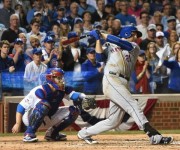
Since Lucas Duda became the Mets everyday first baseman in 2014, he has been amongst the best first baseman in baseball. Beginning in 2014, Duda has amassed a 6.6 WAR, which is better than 21 of the players projected to open the season as their team’s Opening Day first baseman. Can you name those 21 players? Good luck!

In the Men’s Fitness article about David Wright and his spinal stenosis, we learn about what Wright must endure to step on the field each and every day.
In order to step on the field after his spinal stenosis diagnosis, he had to rebuild his core to take pressure off of his back. He had to learn a new swing so the torque wouldn’t hurt his back further. He then had to learn a new pregame routine. He shows up at 1:00 for a 7:00 game. While he does less baseball activities now pregame, he does a lot more work just to get his back ready to play in a game. Read that again. It takes Wright six hours to get ready for a night game.
That’s just getting ready for a single game. Throughout the offseason, Wright has continued his grueling rehab and workouts. It’s incredible to think of how much work goes into allowing Wright to play one game let alone a full 162 game schedule.
Reading all of this, there are some conclusions that can be drawn. First, there is simply no way Wright can play in a day game this year. To get ready for a 1:00 P.M. game, he would have to arrive at the ballpark at 7:00 A.M. to start working. That’s if he’s recuperated enough from the prior night’s game to start working out that early in the morning.
The next conclusion we can draw from this is Terry Collins is going to let Wright play in as many games as Wright believes he can play. Regardless of whether Wright is set to play, he has to put the work in each and every day. If Wright is going to put the work in, he’s going to want to play. Collins trusts his players, and he will trust that Wright is ready to play each time he arrives at the ballpark and declares himself fit to play.
The final conclusion is we really have no idea how many games Wright will be able to play in 2016. Wright is uncharted territory. Typically, an injury like his forces a player to retire. Wright hasn’t. Instead, he’s rehabbing. He’s putting the work in both on game days and off days.
Wright is doing everything humanly possible to play. In 2016, each time he announces he’s ready to go, Collins will pencil his name into the lineup. How many times? We don’t know yet. How will Wright play when he does get to play? We don’t know that either.
The only thing we do know is Wright will do everything he can do to get out there on the field and play. We’ll have to settle for that right now.
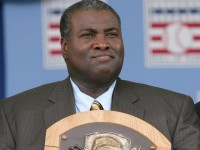
Whether players like it or not, New York City has enacted a smokeless tobacco ban that will prevent them from using chewing tobacco at Citi Field and Yankee Stadium. As we see from the quotes, there are players like Lucas Duda, to whom it’ll have no effect. There are others who do use it. We don’t know what, if any, impact it will have on them.
At this point, no one knows how this will work or how it can be enforced. No one knows how effective it will be. Remember this is the same city that has banned smoking indoors for over a decade, and yet, everyone looks the other way when Yoenis Cespedes sneaks into the clubhouse to have a cigarette. This begs the question of why even bother doing it? These are grown men. No law is going to stop a player from using chewing tobacco. Most players who feel they need it to perform may do it anyway. So why do it?
The answer might be found in Curt Schilling‘s struggles with cancer as he describes in The Players’ Tribune. Schilling started at 16, and he could never stop. As a result, he faced a life or death struggle with mouth cancer. A fight he won; a fight others have lost.
Tony Gwynn died at the age of 54. He started dipping in rookie ball and couldn’t stop. He woke up, brushed his teeth, and then threw in a dip. He’d have a dip in his mouth the rest of the day. He dipped through every scare. He dipped right up until he had cancer.
These are the reasons for the laws. No one wants to see Curt Schilling go through this. This was a man who was unbeatable in October. He got sutures in his ankle just to pitch in the 2004 ALCS and World Series. During the biggest moments, he’s seemingly invincible. No one is invincible when it’s cancer. So whether we agree with the law or not, to a man, we can all agree that we hope it works. We hope it’ll stop people from starting. We hope it’ll get people to quit.
The problem is it won’t. Smokeless tobacco has been banned in the minor leagues since 1993. Despite this ban, minor leaguers come to the majors and use chewing tobacco. Whatever measures baseball has put in place has not stopped players from using it. So no, banning it will not reach the intended goal. Banning something rarely does.
Banning it hasn’t worked, and it won’t work now. Instead, what we have is an avenue for big leaguers to talk about their use and why preventing them from doing it is a bad thing. So in essence, this law is going to have the direct opposite effect of its intention, at least in the short term. Instead, everyone should be looking for real solutions to solve the problem.
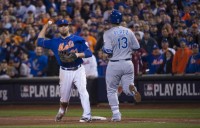
Ask a Mets fan which team is going to represent the National League in the World Series, and you know what their answer will be. In a clubhouse full of confident guys like Matt Harvey, you know to a man the Mets believe they are returning to the World Series.
You know who agrees that the Mets will return to the World Series? Eric Hosmer. As Hosmer told Ebenezer Samuel of the New York Daily News:
You can definitely see the Mets being that team to get back on that stage and win on that stage. Not only did they get experience (from the World Series), but they’ve got guys who have established themselves as superstars in the game. I think the future is bright for those fans in New York.
Of course when talking about the reasons why the Mets can return to the World Series, Hosmer invokes the pitching staff, especially Harvey, Jacob deGrom, and Noah Syndergaard. As Hosmer notes, “. . . the hardest thing is to be able to have the quality starting pitching and not only have the quality but to have the depth as well. They have it, and they will be more comfortable in the playoffs.”
What was surprising was in addition to the Mets starting pitching, Hosmer named Lucas Duda as a reason why the Mets could repeat as National League pennant winners. He didn’t name Yoenis Cespedes who electrified the Mets when he joined them after the trade deadline. He didn’t name Michael Conforto, who hit two home runs in a World Series game and who refused to make the last out of the World Series. He didn’t even name Curtis Granderson who hit three home runs in the World Series. He named Lucas Duda whose poor throw home in Game 5 allowed Hosmer to score the game tying run. Why him? Well according to Hosmer, we shouldn’t judge Duda based upon one throw:
The fact that it happened in the ninth inning magnified the situation more, but if you look at what Duda did, he was the one who got multiple RBI hits for them (that game) and got things going. I think that play, it’s a small sample size of what actually happened for him in the World Series.
Hosmer is right, and he should’ve taken it a step further. Duda has been terrific for two plus seasons now, and yet, there will always be a segment of the fan base that will judge him solely for that one throw.
In Duda’s first two full seasons as the Mets first baseman, he has hit .249/.350/.483 with 57 homers and 165 RBI. His OPS+ is 134, and he has a cumulative 6.6 WAR. In the NL East clincher, he hit the grand slam keynote address. He hit another grand slam in the fourth and deciding game of the NLCS. Overall, Duda is as good a first baseman as there is in baseball. He is a legitimate power threat in the middle of the Mets lineup. He gets on base to boot.
So yes, Hosmer is correct in pointing out that Duda is a big reason why the Mets can and will return to the World Series. Overall, between the Mets pitching and hitting from players like Duda, they are good bets to return to and win the World Series.

A pitcher has an 8.10 ERA? Big deal. Your starting pitcher is missing a few miles per hour on his fastball? It’s still early. It’s Spring Training. You don’t get upset about things like this in Spring Training.
Except the regular season is less than two weeks away, and Jacob deGrom has yet to throw it over 93 MPH. He’s had some leg and back problems in Spring Training. He threw a lot of innings last year. He tired after the NLDS. Should Mets fans at least start getting concerned that one of their three aces still has diminished velocity this close to the regular season? Well, if the scouts are right, not yet:
Anyhow, couple scouts shrugged of deGrom’s velocity. Again, it's spring after all. He also had a weird schedule with the leg and back thing.
— Marc Carig (@MarcCarig) March 21, 2016
If not today, then when? deGrom has two starts left before he toes the rubber in Kansas City for the second game of the season. Of course with his wife expecting, that schedule can get thrown out of whack. When deGrom’s son is born, he intends to be there. This will further throw a wrench into deGrom’s ability to get ready for the season and/or find those extra few miles per hour.
Perhaps deGrom already has them. Perhaps he wasn’t bringing his best stuff against a Marlins team the Mets will face 19 times this year. Maybe he is saving those bullets for the regular season and postseason rather than wasting them in Spring Training. Because it is Spring Training, anything is still possible.
But at some point, it will no longer be Spring Training. At some point, we will learn that either deGrom has his fastball, or he doesn’t. Today is not the day. It’s too soon to be worried about deGrom’s arm. However, that time is coming fast. Hopefully, that day will never come.
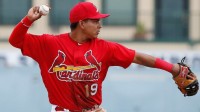
One of the interesting subplots to the 2016 season was going to be when Chase Utley stepped into the batter’s box against the Mets. One of the young Mets hurlers was going to have a chance to plunk Utley as retribution for what he did to their teammate, Ruben Tejada.
The problem is Tejada is no longer a Met. He’s a Cardinal. He’s off trying to help some other team try to win a World Series. When the Cardinals face the Dodgers, I’m sure it’ll be news that Utley and Tejada are facing each other for the first time since the NLDS. However, I doubt that Cardinals pitchers will be expected to exact revenge upon Utley for something that didn’t happen while Tejada was wearing a Mets uniform. Does this mean the Mets then have that obligation?
Do the Mets have to go out and plunk Utley? The message here is you went out and injured one of our own on a dirty play. We don’t care if Tejada is wearing another uniform or not, we will still stand up for our guys. It’s a message that the 2016 Mets will not back down to anybody. It’s a message that if you go after one of their players, you will have to answer for it.
Of course, it would be perfectly justifiable for the Mets to not plunk Utley. The 2016 Mets can still be the team that doesn’t back down to anyone without hitting Utley. While the Mets might still be upset over the play, Tejada is a Cardinal. They very reasonably could determine it’s up to the Cardinals to handle Utley now.
Overall, it’s fair to say the Mets are in a no-lose situation no matter how they choose to handle this situation. Actually, no, the Mets are in a no-lose situation so long as they don’t repeat the Shawn Estes situation.
Editor’s Note: this also appeared on metsmerizedonline.com
